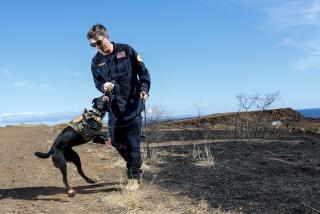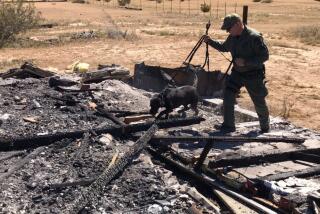Using Dogs to Sniff Out Suspect at Issue in Murder Case
- Share via
He was brought in to help police solve a grisly double murder. But instead of the traditional photo lineup of suspects, he was exposed to a series of the scents they left.
Sniffing the five odors, Reilly, a 9-year-old chocolate Labrador retriever, signaled his choice: 15-year-old Michael Hrayr Demirdjian, who is now facing trial as an adult in the bludgeoning deaths of two boys on a La Crescenta playground last year.
With jury selection set to start next week, prosecutors and Demirdjian’s attorney are battling over the use of canine identifications at trial.
A key issue is the technique of using a dog to pick a person out of a scent lineup, for which--attorneys on both sides say--there is no direct legal authority under California law.
“It’s a new and upcoming tool for law enforcement,” said Sgt. Bill Thompson, supervisor of the Los Angeles County Sheriff’s Department’s canine and horse unit, to which Reilly belongs. “Dogs don’t lie.”
Demirdjian’s attorney, Charles T. Mathews, argued in court papers that the identification by a dog can be unreliable. “We’re first assuming that the scent is recognized or accurate,” Mathews said, adding that a dog handler’s conscious or unconscious cues may influence an animal’s actions. “You don’t know what the dog is reacting to.”
Dogs have played an important role in the police investigation of the killings of Blaine Talmo Jr., 14, and Christopher McCulloch, 13, on July 23.
Deputy Dist. Atty. Steven Barshop alleges that Demirdjian, who faces two counts of murder and two counts of robbery, robbed and killed the boys after fighting with one of them a few days earlier.
Mathews contends that his client was merely a witness to the killings, which he alleges were committed by another teenager. The other youth was arrested last July on suspicion of murder, but was released without being charged in that case.
At the crime scene the night the bodies were found, a 6-year-old honey-colored bloodhound named Scarlett picked up a scent trail from a rock believed to have been one of the murder weapons, according to court documents filed by prosecutors.
Scarlett tracked a path from where the victims were found on the school grounds to a bloodstained gate, and then to the house where Demirdjian lived, prosecutors said.
Inside, police found blood on doors, blood on the youth’s bed and a trash bag containing his blood-stained shoes and a wallet that belonged to one of the dead boys. Police say DNA tests eventually showed some of the blood from the house matched that of one victim.
The next day, after Demirdjian was taken to the Glendale Police Station for questioning, Scarlett was again there. She again sniffed the pad containing the odors from the crime-scene rock and then charged through the police station to one interview room, and then another until she found Demirdjian, according to prosecutors.
About four weeks later, police brought in Reilly, one of the oldest and most experienced members of the sheriff’s search dog team, and gave him a scent lineup containing the odors of Demirdjian, the youth Demirdjian alleges committed the slayings, and three other people.
Reilly matched Demirdjian’s scent with that from the rock found at the slaying scene, but excluded that of the other youth, prosecutors said.
Although California courts generally allow dog-tracking evidence if the dog was trained, reliable, handled by a qualified person and was put on an uncontaminated trail, there is no known state case law so far on scent lineups, both sides have said.
Courts in other states are divided as to whether scent lineup evidence is admissible, Mathews said. Evidence from a scent lineup was admitted in a case last year in Pasadena, the only prior case that prosecutors could recall.
Barshop, the prosecutor, said: “This is cutting edge . . . the entire area dealing with dog tracking.”
More to Read
Sign up for Essential California
The most important California stories and recommendations in your inbox every morning.
You may occasionally receive promotional content from the Los Angeles Times.













